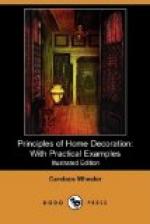Fortunately many ancient marvels of needlework were done upon white satin, and this makes them easily adaptable to any light scheme of colour, where they may appear indeed as guests of honour—invited from the past to be courted by the present. It is not often that such pieces are offered as parts of a scheme of modern decoration, and the fingers of to-day are too busy or too idle for their creation, yet it sometimes happens that a valuable piece of drapery of exceptional colour belongs by inheritance or purchase to the fortunate householder, and in this case it should be used as a picture would be, for an independent bit of decoration.
To return to simple things, the rule of contrast as applied to papered walls, covered with design, ordains that the curtains should undoubtedly be plain and of the most pronounced tint used in the paper. If the walls of a room are simply tinted or painted, figured stuffs of the same general tone, or printed silks, velvets, or cottons in which the predominant tint corresponds with that of the wall should be used. These relieve the simplicity of the walls, and give the desirable variation.
Transparent silk curtains are of great value in colouring the light which enters the room, and these should be used in direct reference to the light. If the room is dark or cold in its exposure, to hang the windows with sun-coloured silk or muslin will cheat the eye and imagination into the idea that it is a sunny room. If, on the contrary, there is actual sunshine in the room, a pervading tint of rose-colour or delicate green may be given by inner curtains of either of those colours. These are effects, however, for which rules can hardly be given, since the possible variations must be carefully studied, unless, indeed, they are the colour-strokes of some one who has that genius for combination or contrast of tints which we call “colour sense.”
After colour in draperies come texture and quality, and these need hardly be discussed in the case of silken fabrics, because silk fibre has inherent qualities of tenacity of tint and flexibility of substance. Pure silk, that is silk unstiffened with gums, no matter how thickly and heavily it is woven, is soft and yielding and will fall into folds without sharp angles. This quality of softness is in its very substance. Even a single unwoven thread of silk will drop gracefully into loops, where a cotton or linen or even a woollen thread will show stiffness.
Woollen fibre seems to acquire softness as it is gathered into yarns and woven, and will hang in folds with almost the same grace as silk; but unfortunately they are favourite pasture grounds as well as burying-places for moths, and although these co-inhabitants of our houses come to a speedy resurrection, they devour their very graves, and leave our woollen draperies irremediably damaged. It is a pity that woollen fabrics should in this way be made undesirable for household use, for they possess in a great degree the two most valuable qualities of silk: colour-tenacity and flexibility. If one adopts woollen curtains and portieres, constant “vigilance is the price of safety,” and considering that vigilance is required everywhere and at all times in the household, it is best to reduce the quantity whenever it is possible.




